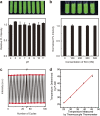Intracellular Temperature Sensing: An Ultra-bright Luminescent Nanothermometer with Non-sensitivity to pH and Ionic Strength
- PMID: 26445905
- PMCID: PMC4597201
- DOI: 10.1038/srep14879
Intracellular Temperature Sensing: An Ultra-bright Luminescent Nanothermometer with Non-sensitivity to pH and Ionic Strength
Abstract
Luminescence thermometry usually suffer from cellular complexity of the biochemical environment (such as pH and ionic strength), and thus the accuracy and reliability of the determined intracellular temperature are directly affected. Herein, a photoluminescent nanothermometer composed of polymer encapsulated quantum dots (P-QD) has been developed. And the prepared nanothermometer exhibits some advantages: such as non-sensitivity to pH and ionic strength, as well as high detection sensitivity and ultrahigh reversibility. The intracellular temperature was accurately determined under physiological conditions with different pH and ionic strength, and direct measurement of thermogenesis in individual cells has been achieved.
Figures




Similar articles
-
Ratiometric Fluorescent Polymeric Thermometer for Thermogenesis Investigation in Living Cells.Anal Chem. 2015 Oct 20;87(20):10535-41. doi: 10.1021/acs.analchem.5b02791. Epub 2015 Oct 1. Anal Chem. 2015. PMID: 26393404
-
Real-Time Intracellular Temperature Imaging Using Lanthanide-Bearing Polymeric Micelles.Nano Lett. 2020 Sep 9;20(9):6466-6472. doi: 10.1021/acs.nanolett.0c02163. Epub 2020 Aug 4. Nano Lett. 2020. PMID: 32787172
-
Red-Emitting Carbon Nanodot-Based Wide-Range Responsive Nanothermometer for Intracellular Temperature Sensing.Anal Chem. 2020 Dec 1;92(23):15632-15638. doi: 10.1021/acs.analchem.0c03912. Epub 2020 Nov 10. Anal Chem. 2020. PMID: 33170648
-
The challenge of intracellular temperature.Biophys Rev. 2020 Apr;12(2):593-600. doi: 10.1007/s12551-020-00683-8. Epub 2020 Mar 14. Biophys Rev. 2020. PMID: 32172449 Free PMC article. Review.
-
Luminescent chemosensors based on semiconductor quantum dots.Phys Chem Chem Phys. 2007 May 7;9(17):2036-43. doi: 10.1039/b616017d. Epub 2007 Feb 1. Phys Chem Chem Phys. 2007. PMID: 17464385 Review.
Cited by
-
Ultrabright fluorescent nanothermometers.Nanoscale Adv. 2021 Jul 17;3(17):5090-5101. doi: 10.1039/d1na00449b. eCollection 2021 Aug 25. Nanoscale Adv. 2021. PMID: 36132344 Free PMC article.
-
Imaging the pharmacology of nanomaterials by intravital microscopy: Toward understanding their biological behavior.Adv Drug Deliv Rev. 2017 Apr;113:61-86. doi: 10.1016/j.addr.2016.05.023. Epub 2016 Jun 4. Adv Drug Deliv Rev. 2017. PMID: 27266447 Free PMC article. Review.
-
Less is more: dimensionality reduction as a general strategy for more precise luminescence thermometry.Light Sci Appl. 2022 Jul 27;11(1):237. doi: 10.1038/s41377-022-00932-3. Light Sci Appl. 2022. PMID: 35896538 Free PMC article.
-
Intracellular thermometry with fluorescent sensors for thermal biology.Pflugers Arch. 2018 May;470(5):717-731. doi: 10.1007/s00424-018-2113-4. Epub 2018 Feb 4. Pflugers Arch. 2018. PMID: 29397424 Free PMC article. Review.
-
Intracellular ratiometric temperature sensing using fluorescent carbon dots.Nanoscale Adv. 2018 Dec 10;1(1):105-113. doi: 10.1039/c8na00255j. eCollection 2019 Jan 15. Nanoscale Adv. 2018. PMID: 36132472 Free PMC article.
References
-
- Gota C., Okabe K., Funatsu T., Harada Y. & Uchiyama S. Hydrophilic Fluorescent Nanogel Thermometer for Intracellular Thermometry. J. Am. Chem. Soc. 131, 2766–2767 (2009). - PubMed
-
- Wang X. D., Wolfbeis O. S. & Meier R. J. Luminescent probes and sensors for temperature. Chem. Soc. Rev. 42, 7834–7869 (2013). - PubMed
-
- Alivisatos A. P., Gu W. W. & Larabell C. Quantum dots as cellular probes. Annu. Rev. Biomed. Eng. 7, 55–76 (2005). - PubMed
-
- Hsia C. H., Wuttig A. & Yang H. An Accessible Approach to Preparing Water-Soluble Mn2+-Doped (CdSSe)ZnS (Core)Shell Nanocrystals for Ratiometric Temperature Sensing. ACS Nano 5, 9511–9522 (2011). - PubMed
Publication types
LinkOut - more resources
Full Text Sources
Other Literature Sources

